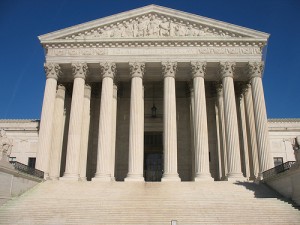In a unanimous opinion in McCullen v. Coakley, the Supreme Court held that a Massachusetts statute making it a crime to stand on a public road or sidewalk within 35 feet of an abortion clinic violates the First Amendment.
the Supreme Court held that a Massachusetts statute making it a crime to stand on a public road or sidewalk within 35 feet of an abortion clinic violates the First Amendment.
Massachusetts adopted this statute because protesters routinely violated a previous statute. Petitioners were “sidewalk counselors” who claimed the buffer zones prevented them from having personal interactions with those entering the clinics which they viewed as essential to their “sidewalk counseling.”
The State and Local Legal Center’s (SLLC) amicus brief points out that cities frequently use buffer zones in numerous contexts. For example, prior to McCullen, lower courts upheld buffer zones to prevent congestion at special events and places that regularly draw crowds and near funerals to protect vulnerable mourners.
McCullen begs an obvious question: will any buffer zone statutes and ordinances survive constitutional scrutiny now?
While only time will tell how lower courts will interpret McCullen, the opinion provides a detailed analysis lower courts are likely to apply to future buffer zone cases.
Almost all buffer zones are created in response to a specific problem (circus buffer zones: think animal rights protesters). This may not mean that lower courts will consider such buffer zones content-based. In McCullen, the Court concluded that Massachusetts’ buffer-zone law was content-neutral despite the fact that
Massachusetts regulated speech only outside abortion clinics and not outside every building that might host an event that could attract protesters. The Massachusetts legislature identified a problem only at abortion clinics and reasonably decided to regulate speech only at abortion clinics.
Massachusetts lost in McCullen because the Court concluded its buffer zone law wasn’t “narrowly tailored to serve a significant government interest.” Lower courts are likely to look at all of the reasons the Court relied on when determining if a buffer zone in another context is constitutional.
First, McCullen wasn’t a protester, she was a “sidewalk counselor” who could only work effectively if she could have close, personal conversations with women. More traditional protesters wielding signs and megaphones may not have as persuasive of an argument that they need to get really close to their audience.
Second, the Chief Justice recommended that Massachusetts try to solve its public safety problems at abortion clinics by harassment and obstruction statutes and ordinances which are more targeted than buffer zones. A related reason the Court thought the buffer zones were overkill was that only one clinic in the state had problems on Saturday mornings only. So, when evaluating whether a buffer zone is narrowly tailored a lower court is likely going to look at whether effective options not so burdensome to free speech were available.
Finally, the Court didn’t buy Massachusetts’ argument that it tried other laws already on the book to solve the problems caused by protesters at abortion clinics but they did not work. Massachusetts could not cite to a single prosecution in 17 years and their last injunction dated to the 1990s. In short, cities that adopted buffer zone laws because “everything else failed” are going to have to prove it.
Image courtesy of Flickr from Kjetil Ree (creative-commons license, no changes made).
